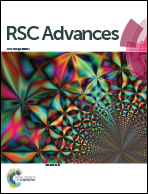Synthesis and photoluminescence modulating of polypyrrole fluorescent nano-spheres/dots†
Abstract
Polypyrrole (PPy) nanospheres with an average diameter of 20 nm were successfully synthesized by simply using 3-chloroperbenzoic acid in pure ethanol. As-prepared PPy nanospheres showed a moderate photoluminescence signal with a quantum yield (QY) of 2.2% and excitation-dependent photoluminescence characteristics. To carry out the PPy nanosphere surface functionalization, PEG2000, 4,7,10-trioxa-1,13-tridecanediamine and ethylenediamine severed respectively as surface passivating agents, and accordingly 5.5 nm, 4.5 nm and 3 nm sized nanodots were obtained, which exhibited enhanced fluorescence intensity with maximum QYs of 3.1%, 13% and 40% respectively and tunable band gaps in the range of 0.78–1.53 eV. These results were attributed to the increased electron density in PPy fluorescent nanospheres/dots. These resultant PPy fluorescent nanodots could be appropriately applied as cell-imaging agents, fluorescent inks and pH sensors owing to their outstanding characteristics of low cytotoxicity, good biocompatibility and high luminescence stability.


 Please wait while we load your content...
Please wait while we load your content...